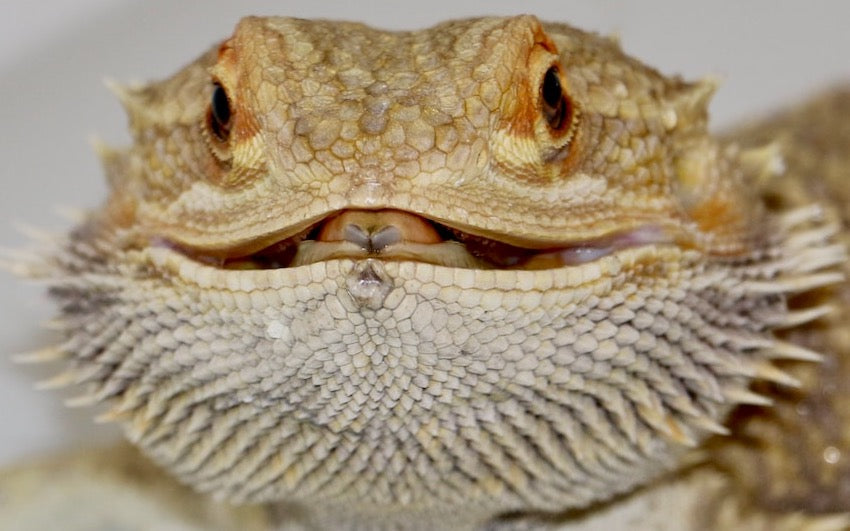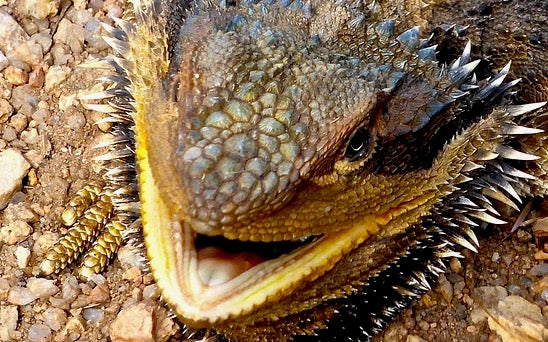Bearded dragon tongues are fascinating. They are forked (almost imperceptibly), sticky, and thick—in some ways resembling a snake’s tongue, but in many ways not. (Forked, sticky, and thick: try getting your tongue around that!)
The bearded dragon tongue doesn’t extend out very far, and lacks the flicking action that is characteristic of snakes, chameleons, and komodo dragons. However, bearded dragon tongues still have the key elements that make lizard tongues so interesting.
Let’s find out more about bearded dragon tongues, including what a healthy bearded dragon tongue looks like, what the tongue is used for, and when to call a vet.
What Does a Bearded Dragon Use Its Tongue For?
There are two main functions of a bearded dragon’s tongue…eating and smelling.
Bearded Dragons Use their Tongue for Eating
The bearded dragon’s tongue is used for eating, of course. The tip of the tongue has a sticky surface which helps capture prey and veggies, drawing the food into the mouth to be chomped.
Bearded Dragons Use Their Tongue for Smelling
Yes, you read that right! Bearded dragons smell with their tongue.
Humans and lizards both smell by capturing tiny molecules that the brain then interprets as an odor. Humans accomplish this with their nose…but lizards—including bearded dragons—use their tongue!
“Just like snakes, a lizard sticks out its tongue to catch scent particles in the air and then pulls back its tongue and places those particles on the roof of its mouth, where there are special sensory cells. The lizard can use these scent “clues” to find food or a mate or to detect enemies.” (Source: San Diego Zoo)
As we mentioned earlier, a bearded dragon's tongue is forked, which helps determine where a smell is coming from.
The Jacobson’s organ, which is located on the roof of the bearded dragon’s mouth, is what allows the dragon to smell.

How Long Is a Bearded Dragon’s Tongue?
Unlike some lizards, bearded dragons have fairly short tongues. They won’t extend too far out of the bearded dragon’s mouth—maybe an inch or so. Dragons don’t rely on their tongues primarily for catching food, like chameleons do. They use the tongue to help smell, identify, and follow the prey; their speedy legs propel them to the insect and when they’re getting close, the sticky tongue helps pull the unlucky bug in to be eaten.
Healthy vs Unhealthy Bearded Dragon Tongue
If you’re not too familiar with reptiles (or even if you are), chances are at some point, you’ve caught a glimpse of your bearded dragon’s mouth and wondered, what’s wrong with my bearded dragon’s tongue? Is it normal?
So how do you know if your dragon’s tongue is normal or not, healthy or unhealthy?
A normal bearded dragon tongue:
- Is forked (you have to really look to notice it, though)
- Is short and sticky
- Spreads a little, but not much
- Usually has a white or light colored tip (sometimes with a small dark spot)
An unhealthy bearded dragon tongue will be lacking one or more of those characteristics.
What Color Should a Bearded Dragon’s Tongue Be?
A bearded dragon’s tongue usually has a white or light colored tip (yellow or light pink); the rest is usually a salmon-pinkish color. So if the tip of your dragon’s tongue has a white, yellowish, or pinkish color, and there are no other signs for concern, then chances are your dragon is fine.
However, you should call your vet if you notice the tip of your dragon’s tongue is one of the following unhealthy colors:
- Black (a black tip could mean mouth rot, which needs to be treated immediately or it can become deadly)
- Blue
- Grey
- White (only problematic if the entire throat or tongue is white; a white tipped tongue is normal)
Why Do Bearded Dragons Stick Their Tongues Out?
When bearded dragons stick their tongue out frequently they’re usually letting their mouth hang open as well. So if you notice your dragon exhibiting either of these behaviors—or both—it could be due to one of the following factors:
- They’re getting ready to eat. Of course, this is the most basic reason your dragon would be sticking out its tongue. It’s feeding time!
- Tasting or smelling. In addition to catching their food, bearded dragons use their tongue to gather information by sniffing around and tasting their environment.
- Exploring something new. If you’ve just put your dragon in a new enclosure or put a new piece of decor in the tank, you may notice your dragon licking it. This behavior will likely stop once your dragon gets used to the new item.
- Regulating body temperature. Sometimes bearded dragons open their mouths to help regulate their body temperature. This is common behavior after basking.
- Fear or stress. If your dragon is sticking out his tongue and puffing out his beard, he may be feeling afraid or stressed.
- Respiratory infection. If your dragon is panting pervasively, and not just opening his mouth after basking, give your vet a call; this may be a sign of a respiratory infection, which requires immediate intervention.
A respiratory infection can get pretty serious pretty quickly.
Symptoms include:
- Visible difficulty breathing (shallow, rapid breaths; abdominal straining)
- Mucousy discharge from the mouth and nose
- Decrease in activity and appetite
If you suspect a respiratory infection, don't wait! Call your vet.

Addressing Bearded Dragon Mouth Rot (Sometimes Called Tongue Rot)
If you ever notice the following symptoms in or around your bearded dragon's mouth and tongue, something is wrong, and you should call your vet immediately. It could be mouth rot (infectious stomatitis) or another potentially life-threatening dental disease.
Mouth rot symptoms include:
- Inflammation
- Broken teeth
- Loss of appetite
- Discharge and excess mucus in mouth
- Sores and bleeding on gums or other parts of the mouth
- Dental decay
- Yellow or gray coloring instead of pink inside the mouth
Many of these symptoms are characteristic of multiple types of dental disease, including gum infection and gingivitis.
Mouth rot must be treated as soon as possible to prevent more serious issues such as the disease spreading to the jaw and bones. This disease can kill your dragon if left untreated. Your vet can recommend a treatment plan that may include antibiotics and anti-inflammatory medication to help fight the infection. If your dragon is struggling to eat due to the discomfort in the mouth, your vet can help you determine whether force feedings are necessary, and how to administer them safely.
If there is buildup on the teeth along with mouth rot (or even aside from mouth rot) your vet may show you how to brush your bearded dragon’s teeth.
If your dragon gets to the point where they have mouth rot, you can expect treatment to include medication at minimum and surgery at maximum. After successful treatment, you’ll need to diligently keep an eye on your bearded dragon’s teeth and have them examined at regular checkups.
Preventing Unhealthy Bearded Dragon Mouth & Tongue
So, what causes mouth/tongue/oral problems like mouth rot and dental disease? According to Reptile Magazine, it boils down to stress:
“The causes of infectious stomatitis are many, but the underlying common denominator is usually related to stress, which causes the immune system to function improperly.”
Prevention is better and easier than treatment! And luckily prevention is fairly easy. Practice good husbandry, feed your dragon a proper diet, and minimize stress in its environment, and your dragon can live a happy, healthy life.
Takeaway: Bearded dragons use their tongue for eating and smelling. A healthy bearded dragon tongue is forked and pink with a light colored tip. There are many reasons why a bearded dragon sticks out its tongue and opens its mouth; some are normal, like eating or exploring something new, and some are signs of a problem, such as illness or difficulty regulating their body temperature. If you take good care of your dragon, you are optimizing the chance that there won’t be any health issues with the mouth, tongue, or anything else!
Sources & Further Reading
https://thereptileroom.net/why-does-my-bearded-dragon-licking/
https://www.vetmed.ucdavis.edu/news/bearded-dragons-oral-diseases-treated
https://animals.sandiegozoo.org/animals/lizard/
https://reptilesmagazine.com/identify-and-treat-mouth-shell-and-scale-rot-in-reptiles/
https://www.reptiledirect.com/bearded-dragon-mouth-open/
---
Got questions or feedback? We want to hear from you! Email us at team@dragonsdiet.com








